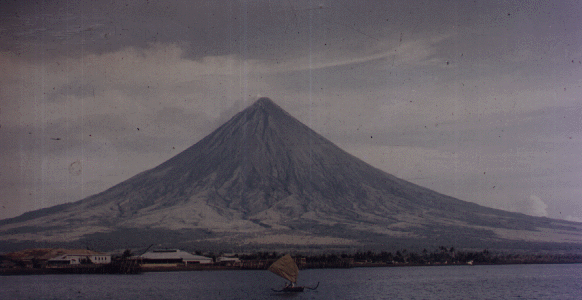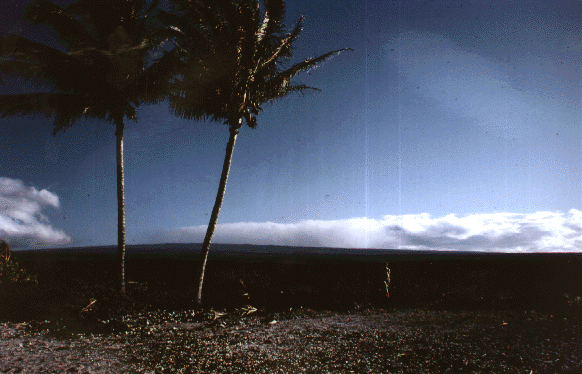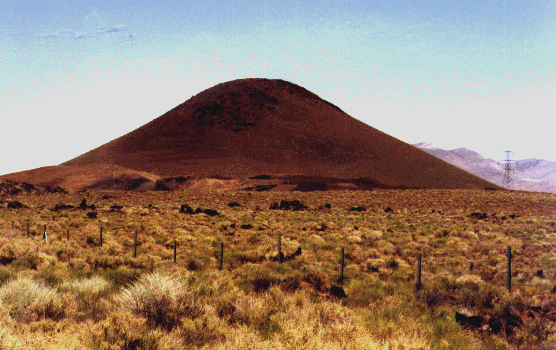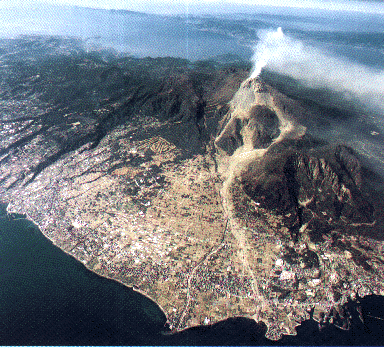

A volcano is a mound, hill or mountain constructed by solid fragments, lava flows, and or dome-like extrusions deposited around a vent from which the material is extruded. The vent is a conduit that extends from the earth's upper mantle or lithosphere to the surface. Most of the material is deposited close to the vent, but some is carried high into the atmosphere to be spread by winds hundreds or thousands of kilometers from the source.

Shield volcanoes are large volcanoes with broad summit areas and low-sloping sides (shield shape) because the extruded products are mainly low viscosity basaltic lava flows. A good example of a shield volcano is the Island of Hawaii (the "Big Island"). The Big Island is formed of five coalesced volcanoes of successively younger ages, the older ones apparently extinct. Mauna Loa, one of the main volcanoes, has a higher elevation than any mountain on earth -- 9090 meters (30,000 feet) from the floor of the ocean to its highest peak.
Shield volcanoes have summit calderas formed by piston-like subsidence. Subsidence occurs when large volumes of lava are emptied from underground conduits; withdrawal of support leads to collapse. Many smaller pit craters also occur along fissure zones on the flanks of the volcanoes. These form by collapse due to withdrawal of magma along conduits.

Cinder cones are mounds of basaltic fragments. Streaming gases carry liquid lava blobs into the atmosphere that rain back to earth around the vent to form a cone. The lava blobs commonly solidify, or partially solidify, during flight through the air before landing on the ground. They are called "bombs." If gas pressure drops, the final stage cinder cone construction may be a lava flow that breaks through the base of the cone. If abundant water in the environment has access to the molten magma, their interaction may result in a maar volcano rather than a cinder cone.
The longer the eruption the higher the cone. Some are no higher than a few meters and others rise to as high as 610 meters or more, such as Paricutin volcano, Mexico, that was in nearly continuous eruption from 1943 to 1952. Along with pyroclastic activity were lava flows that flowed from its base to destroy the village of Paricutin. Cinder cones can occur alone or in small to large in groups,, or fields.

Composite volcanoes are built by multiple eruptions, sometimes recurring over hundreds of thousands of years, sometimes over a few hundred. Andesite magma, the most common but not the only magma type, tends to form composite cones. Although andesitic composite cones are built mostly of fragmental debris, some of the magma intrudes fractures within the cones to form dike or sills. In this way, multiple intrusive events build a structural framework of dikes and sills that knits together the voluminous accumulation of volcanic rubble. Such a structure can stand higher than cones composed only of fragmental material. Composite cones can grow to such heights that their slopes become unstable and susceptible to collapse from the pull of gravity.
Famous examples of composite cones are Mayon Volcano, Philippines, Mount Fuji in Japan, and Mount Rainier, Washington, U.S.A. Some composite volcanoes attain two to three thousand meters in height above their bases. Most composite volcanoes occur in chains and are separated by several tens of kilometers. There are numerous composite volcano chains on earth, notably around the Pacific rim, known as the "Rim of Fire".

Lava domes form by the slow extrusion of highly viscous silica-rich magma. Most domes are rather small, but can exceed 25 cubic km in volume. Domal extrusions may end up as rather slow-moving lavas but many begin explosively, forming reamed-out explosion pits blanketed by pyroclastic debris. The explosive activity wanes as the gas content decreases. With lowered gas pressures, the magma extrudes slowly as viscous lava that forms thick stubby flows, or domes that are spinal or dome-shaped. As a dome enlarges, its margins slowly creep outward as a lava flow with steep cliff-like margins and a rubbly surface. If protrusion occurs on a steep slope, dome margins can collapse in a dangerous mass of hot rubble that can form pyroclastic flows. Domes can be solitary volcanoes, form in clusters, grow in craters or along the flanks of composite cones. A dome has been growing slowly within the crater of Mount St. Helens since the eruption of 1980. Domes have also filled the crater of Mt. Pelée, Martinique, and many other volcanoes.
The eruption of Mount Unzen, Japan taught volcanologists a valuable lesson -- that the collapse of an active dome can cause pyroclastic flows to develop. From 1991 to 1995, the continued growth and partial collapse of the Mount Unzen dome initiated hundreds of small but highly destructive pyroclastic flows and surges.

The area of caldera collapse is about proportional to the volume of erupted material. Depths of subsidence as indicated by thickness of caldera fill is 1 to 3 km or more. Structural boundaries of calderas are commonly single or composite ring fault zones along which initial collapse took place. In deeply eroded calderas these structural boundaries may be expressed by a ring dike emplaced along arcuate faults during or after collapse.
The 1883 Krakatau eruption showed that caldera formation and pyroclastic eruptions are interrelated. Pyroclastic flow processes were first recognized following the 1902 eruption of Mont Pelee, Martinique, and in 1942, a volcanologist from Berkeley, Professor Howell Williams, demonstrated that many calderas form by collapse following large pyroclastic eruptions. It is now generally accepted that all silicic eruptions having volumes greater than 50 km3 are associated with caldera collapse. The many large Cenozoic ignimbrite sheets (pyroclastic flow and surge deposits) in the western United States suggests that there are 250 to 500 caldera structures, although no more than 100 have been identified; about one-fourth of them are associated with ore mineral deposits.
Many calderas are associated with important ore deposits, commonly lead-zinc-silver-gold, but also copper, moybdenum, tungsten, beryllium and uranium, and are associated with geothermal systems that originate in the volcano-plutonic transition zone. Steam from geothermal systems is used to run generators for electrical power.
The San Juan Volcanic Field is a 25,000 km2 erosional remnant of a composite volcanic province that once extended over much of the southern Rocky Mountains. Within the San Juan Field there are 17 large-volume ignimbrite sheets (greater than 100 km3) that have been related to 17 caldera collapses.
Most of the San Juan Field is andesitic lavas and breccias erupted between about 35 and 30 m.y. ago. The pyroclastic flow eruptions occurred between about 30 and 23 m.y. ago. San Juan calderas collapsed within clusters of slightly older andesitic stratovolcanoes or within older calderas. Mineralization of some caldera structures range in age from contemporaneous with caldera collapse to as much as 15 m.y. younger.
The second stage of the caldera cycle, culminating eruptions and caldera collapse, is triggered by voluminous eruption of silicic pyroclastic material. Initiating eruptions may be from central vents as indicated by thick fallout pumice beds that commonly precede the emplacement of pyroclastic flow deposits. As eruption of ash removes support, the roof above the shallow-source magma chamber collapses along ring faults to produce the initial caldera depression. Culminating eruptions occur along the ring faults. Collapse probably occurs during the pyroclastic eruptions. Unstable steep scarps outside the ring faults tend to slump into the newly-formed depression, enlarging the topographic diameter and depositing breccias formed by collapse within the caldera. Thick pyroclastic flow deposits emplaced concurrently with collapse commonly occupy most of the caldera crater.
(1) continued volcanism within or near the caldera,
(2) resurgent uplift of the caldera related to renewed rise of the magma. Renewed rise of magma after caldera collapse has caused uplift of many caldera areas. This is called resurgence. It can consist of doming of the central floor of single calderas, or be a broad regional uplift of one or more calderas and close-by areas. Resurgent calderas are more numerous along the continental margin arc of the Americas than in young volcanic arcs elsewhere in the Pacific Basin. Resurgent structures are associated with large calderas greater than 10 km diameter.
(3) sedimentation within the caldera basin commonly within a lake, and
(4) hydrothermal activity and mineralization resulting from the interaction of meteoric water and hot country rock. Postcollapse volcanism can continue for millions of years.
Calderas: American Geophysical Union Special Issue on Calderas, 1984. Journal of Geophysical Research, vol. 89, pages 8219 - 8841.
Copyright (C) 1997, by Richard V. Fisher. All rights reserved.